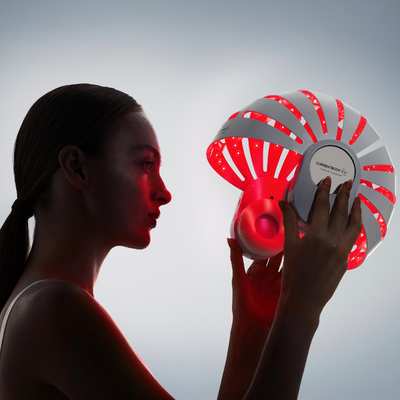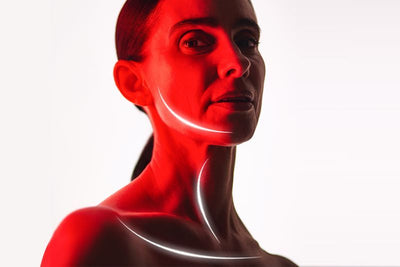What can you do to address skin discoloration now and in the future?
Raise your hand if you’ve got a dark spot or patch of skin that doesn't match your natural skin tone. Chances are you do, as hyperpigmentation is an incredibly common issue faced by practically every human on the planet.
Generally thought of as a by-product of not protecting your skin from UV exposure, hyperpigmentation can actually be caused by a number of other triggers – meaning how you avoid and treat the brown, black, red, grey and even blue patches that many of us dislike can vary.
To demystify all things hyperpigmentation, we quizzed the experts to discover what it is exactly, how to avoid the condition and how best to treat it when it does rear its head.
What is hyperpigmentation?
“Hyperpigmentation is a very general term that describes a number of different situations where there is excessive production of the natural pigment known as melanin by the skin,”
- shares Aesthetic Doctor, Dr. David Jack.
So essentially, hyperpigmentation is the term used when patches of skin become darker than the rest of your complexion. These dark spots or uneven tones happen because your skin produces extra melanin (the natural pigment that gives your skin, hair, and eyes their color.)
What causes hyperpigmentation?
As mentioned hyperpigmentation happens when your skin produces more melanin that usual and there are a few common triggers behind this. Understanding the cause is the first step towards finding the right treatment.
"Yes, melanin production increases whenever the skin is exposed to UV light, but the skin cells responsible for our skin tone (melanocytes) respond to inflammation, as well as certain hormones and chemical messengers in the body such as oestrogen, progesterone, cortisol, and thyroid hormones. Hence why we not only get pigmentation issues as a result of sun exposure, but also when there are hormonal changes in the body such as pregnancy or as a result of inflammatory conditions like breakouts,”
- adds Dr. Jack.
The skin's natural protective response to UV light and also the predisposition to develop certain types of hyperpigmentation is also affected by our genetics, ethnicity and our general levels of inflammation.
As Dr. Jack explains, there are several common causes of hyperpigmentation that can lead to dark spots and uneven skin tone:
- Sun exposure (UV light)
- Hormonal changes
- Inflammation and skin trauma
- Genetics and ethnicity
- Aging and overall health
Understanding the different causes of hyperpigmentation is only part of the picture. Dark spots and uneven tone don’t all look the same, and knowing which type of hyperpigmentation you’re dealing with is key to choosing the right treatment.
What are the three types of hyperpigmentation?
There are three main types of hyperpigmentation, explains Advanced Aesthetician Corina Mihalache, Founder of Ace Skin Health Clinic.
Melasma
“Melasma presents as symmetrical dark patches on the forehead, above the upper lip, cheeks and sometimes the bridge of the nose. It occurs more frequently in women than in men. In melasma, melanocytes are stimulated by the female sex hormones oestrogen and progesterone to produce more melanin pigment when the skin is exposed to the sun. A common form of melasma occurs during pregnancy and is caused by hormonal fluctuations but usually disappears after delivery.”
Post-inflammatory hyperpigmentation (PIH)
“Caused by the overproduction of melanin following inflammation from the likes of breakouts, an allergic reaction, and even by some beauty treatments and ingredients. PIH can occur at any age and on all skin types, but is more common on darker skin tones. The darker the skin, the more intense and persistent PIH tends to be.”
Sunspots
“Varying in color from light brown to dark brown, sunspots usually develop in adults who have been repeatedly exposed to the sun or have suffered from sunburn in the past. They can affect people of all skin types, but they are more common in adults with fair skin, and often appear on frequently exposed areas such as the face, forearms, back of the hands, chest, back, shoulders and lower legs.”
While hyperpigmentation is usually harmless, many people find it frustrating because it makes their skin look uneven or dull.
The good news? With the right skincare, you can fade these dark patches and prevent new ones from forming.

How to prevent hyperpigmentation
“It’s easier to prevent hyperpigmentation than to treat it,” says Mihalache. This makes blocking UV exposure by way of protective clothing and a daily broad-spectrum SPF a must.
Another tried a true method for preventing hyperpigmentation is to work in tyrosinase inhibitors into your skincare regime. “Topical solutions for hyperpigmentation typically work to interrupt the pathways where pigment is produced in the melanocyte cells – they mostly inhibit an enzyme called tyrosinase, which can limit the production of melanin,” shares Dr. Jack.
Actives that do this well include:
- Retinoids
- Vitamin C
- AHAs
- Kojic acid
- Azelaic acid
- Arbutin
- Prescription only hydroquinone
With Dr. Jack adding that, “serums that combine a number of these ingredients have been shown to have quite potent pigment inhibiting effects.”
How to treat hyperpigmentation
Both experts agree that a targeted and consistent skincare regime, peppered with at-home and in-clinic treatments offers the best chances at treating and clearing existing hyperpigmentation.
Here are Mihalache’s must-have skincare actives…
Alpha arbutin
“One of the most widely used skin lightening and de-pigmentation agents in the world, alpha arbutin is a naturally occurring antioxidant and pigment buster found in the bearberry plant. It inhibits tyrosinase activity and slows the rate at which pigment is stored, this effectively lightens existing pigmentation and fades discoloration. What’s more it works well for both UV induced hyperpigmentation and pigmentation caused by inflammation.”
Niacinamide
“This vitamin B3 ingredient interferes with melanin production within the top layer of our skin. This makes niacinamide an ideal active to treat superficial hyperpigmentation caused by sun exposure and an effective preventative agent in patients prone to post-inflammatory hyperpigmentation.”
Vitamin C
“An antioxidant that limits the production of melanin. I usually recommend vitamin C in addition to melanin inhibitors to help protect the skin from UV damage and reduce sun-induced hyperpigmentation in those who spend a lot of time outdoors or live in cities with high levels of air pollution.”
Retinoids
“Derivatives of vitamin A, retinoids like retinol, retinaldehyde, retinyl esters, and retinoic acid work by increasing cell turnover. This natural exfoliation process effectively improves hyperpigmentation by replacing melanin rich damaged cells with new, healthy skin cells. No one form is better than another, as it depends on how well your skin tolerates them. As a rule of thumb those with sensitive skin and darker skin tones should avoid the stronger retinoids and consult a professional before attempting to use higher doses or prescription only retinoic acid.”

At-home treatments for hyperpigmentation
The last thing you want to do at home is pick and prod at your skin too much, especially if you have a reactive skin type prone to inflammation, as you’ll only make your pigmentation issues worse.
But what if you could put on a mask, lie back and relax while beams of light got to work on fading your hyperpigmentation? Well, thanks to the CurrentBody LED Multi Light Therapy Face Mask, this is now a reality.
This flexible mask uses 6 clinically proven LED wavelengths within 5 targeted treatment modes, to address 18 different skin concerns - one being hyperpigmentation – when used for just 10 minutes, three to five times a week.
Red, deep red, and near-infrared light reduce inflammation which we know can trigger hyperpigmentation. While green light, yellow light and near-infrared fade hyperpigmentation, and reduce redness.
In-clinic treatments for hyperpigmentation
According to Dr. Jack:
“When seeing patients in clinic with hyperpigmentation, the key to devising the best treatment plan is to diagnosis the type of hyperpigmentation present - and consider their skin type, their skin tone and ethnicity - as different types of hyperpigmentation and skin types may react differently to more intense in-clinic treatments."
Both experts are big fans of chemical peels, as they can be easily adapted to the type of hyperpigmentation, skin condition and lifestyle of the patient. “I use acids and highly effective pigment inhibitors to exfoliate the skin, promote new skin growth and remove hyperpigmentation," says Mihalache.
So, with a myriad of fixes for this very common skin issue, there’s something for everyone when it comes to evening out your skin tone. All it takes is adopting a consistent skincare regime and treatment protocol that targets your specific form of hyperpigmentation, and protecting your skin from the sun at all times.




